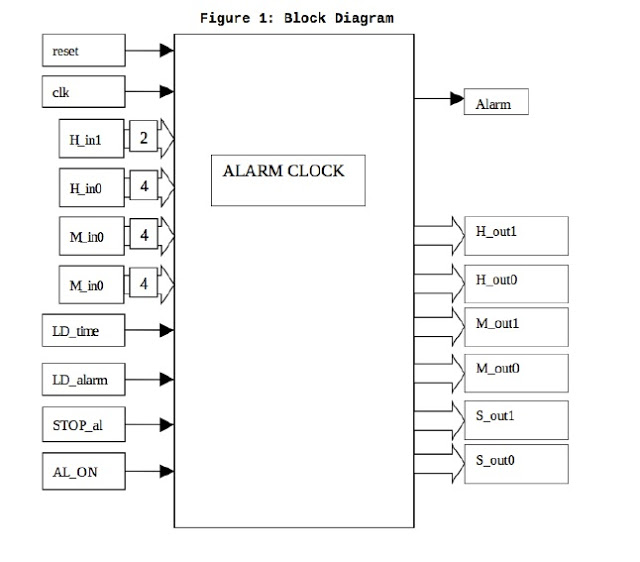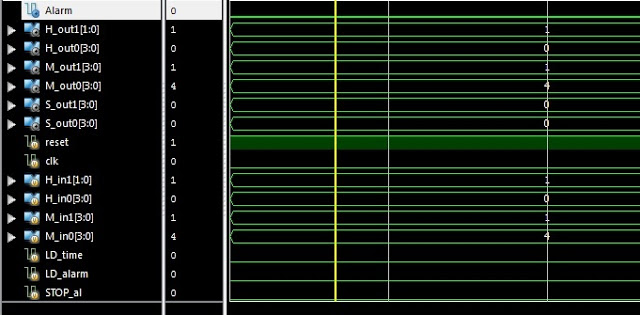FPGA上数字时钟的VHDL代码
此项目是FPGA上数字时钟的VHDL代码。该VHDL项目是Verilog中数字时钟的VHDL版本代码。 数字时钟的VHDL代码可综合用于FPGA实现,并提供完整的VHDL代码。此附件中包括:简单的闹钟示意图、闹钟的完整Verilog代码、闹钟的Testbench Verilog代码、闹钟的仿真波形图。本人在预览区展示了简单的闹钟示意图和闹钟的仿真波形图;如需了解更多请下载附件。
预览截图
应用介绍
此项目是FPGA上数字时钟的VHDL代码。该VHDL项目是Verilog中数字时钟的VHDL版本代码。 数字时钟的VHDL代码可综合用于FPGA实现,并提供完整的VHDL代码。此附件中包括:简单的闹钟示意图、闹钟的完整Verilog代码、闹钟的Testbench Verilog代码、闹钟的仿真波形图。本人在预览区展示了简单的闹钟示意图和闹钟的仿真波形图;同时在下方展示了闹钟的完整Verilog代码;如需了解更多请下载附件。
// fpga4student.com FPGA projects, VHDL projects, Verilog project
module aclock (
input reset, /* Active high reset pulse, to set the time to the input hour and minute (as defined by the H_in1, H_in0, M_in1, and M_in0 inputs) and the second to 00. It should also set the alarm value to 0.00.00, and to set the Alarm (output) low.For normal operation, this input pin should be 0*/
input clk, /* A 10Hz input clock. This should be used to generate each real-time second*/
input [1:0] H_in1, /*A 2-bit input used to set the most significant hour digit of the clock (if LD_time=1),or the most significant hour digit of the alarm (if LD_alarm=1). Valid values are 0 to 2. */
input [3:0] H_in0, /* A 4-bit input used to set the least significant hour digit of the clock (if LD_time=1),or the least significant hour digit of the alarm (if LD_alarm=1). Valid values are 0 to 9.*/
input [3:0] M_in1, /*A 4-bit input used to set the most significant minute digit of the clock (if LD_time=1),or the most significant minute digit of the alarm (if LD_alarm=1). Valid values are 0 to 5.*/
input [3:0] M_in0, /*A 4-bit input used to set the least significant minute digit of the clock (if LD_time=1),or the least significant minute digit of the alarm (if LD_alarm=1). Valid values are 0 to 9. */
input LD_time, /* If LD_time=1, the time should be set to the values on the inputs H_in1, H_in0, M_in1, and M_in0. The second time should be set to 0.If LD_time=0, the clock should act normally (i.e. second should be incremented every 10 clock cycles).*/
input LD_alarm, /* If LD_alarm=1, the alarm time should be set to the values on the inputs H_in1, H_in0, M_in1, and M_in0.If LD_alarm=0, the clock should act normally.*/
input STOP_al, /* If the Alarm (output) is high, then STOP_al=1 will bring the output back low. */
input AL_ON, /* If high, the alarm is ON (and Alarm will go high if the alarm time equals the real time). If low the the alarm function is OFF. */
output reg Alarm, /* This will go high if the alarm time equals the current time, and AL_ON is high. This will remain high, until STOP_al goes high, which will bring Alarm back low.*/
output [1:0] H_out1,
/* The most significant digit of the hour. Valid values are 0 to 2. */
output [3:0] H_out0,
/* The least significant digit of the hour. Valid values are 0 to 9. */
output [3:0] M_out1,
/* The most significant digit of the minute. Valid values are 0 to 5.*/
output [3:0] M_out0, /* The least significant digit of the minute. Valid values are 0 to 9. */
output [3:0] S_out1, /* The most significant digit of the minute. Valid values are 0 to 5. */
output [3:0] S_out0 /* The least significant digit of the minute. Valid values are 0 to 9. */
);
// fpga4student.com FPGA projects, VHDL projects, Verilog project
// internal signal
reg clk_1s; // 1-s clock
reg [3:0] tmp_1s; // count for creating 1-s clock
reg [5:0] tmp_hour, tmp_minute, tmp_second;
// counter for clock hour, minute and second
reg [1:0] c_hour1,a_hour1;
/* The most significant hour digit of the temp clock and alarm. */
reg [3:0] c_hour0,a_hour0;
/* The least significant hour digit of the temp clock and alarm. */
reg [3:0] c_min1,a_min1;
/* The most significant minute digit of the temp clock and alarm.*/
reg [3:0] c_min0,a_min0;
/* The least significant minute digit of the temp clock and alarm.*/
reg [3:0] c_sec1,a_sec1;
/* The most significant second digit of the temp clock and alarm.*/
reg [3:0] c_sec0,a_sec0;
/* The least significant minute digit of the temp clock and alarm.*/
/************************************************/
/*****************function mod10******************/
/*************************************************/
function [3:0] mod_10;
input [5:0] number;
begin
mod_10 = (number >=50) ? 5 : ((number >= 40)? 4 :((number >= 30)? 3 :((number >= 20)? 2 :((number >= 10)? 1 :0))));
end
endfunction
/*************************************************/
/************* Clock operation**************/
/*************************************************/
// fpga4student.com FPGA projects, VHDL projects, Verilog project
always @(posedge clk_1s or posedge reset )
begin
if(reset) begin // reset high => alarm time to 00.00.00, alarm to low, clock to H_in and M_in and S to 00
a_hour1 <= 2'b00;
a_hour0 <= 4'b0000;
a_min1 <= 4'b0000;
a_min0 <= 4'b0000;
a_sec1 <= 4'b0000;
a_sec0 <= 4'b0000;
tmp_hour <= H_in1*10 + H_in0;
tmp_minute <= M_in1*10 + M_in0;
tmp_second <= 0;
end
else begin
if(LD_alarm) begin // LD_alarm =1 => set alarm clock to H_in, M_in
a_hour1 <= H_in1;
a_hour0 <= H_in0;
a_min1 <= M_in1;
a_min0 <= M_in0;
a_sec1 <= 4'b0000;
a_sec0 <= 4'b0000;
end
if(LD_time) begin // LD_time =1 => set time to H_in, M_in
tmp_hour <= H_in1*10 + H_in0;
tmp_minute <= M_in1*10 + M_in0;
tmp_second <= 0;
end
else begin // LD_time =0 , clock operates normally
tmp_second <= tmp_second + 1;
if(tmp_second >=59) begin // second > 59 then minute increases
tmp_minute <= tmp_minute + 1;
tmp_second <= 0;
if(tmp_minute >=59) begin // minute > 59 then hour increases
tmp_minute <= 0;
tmp_hour <= tmp_hour + 1;
if(tmp_hour >= 24) begin // hour > 24 then set hour to 0
tmp_hour <= 0;
end
end
end
end
end
end
/*************************************************/
/******** Create 1-second clock****************/
/*************************************************/
// fpga4student.com FPGA projects, VHDL projects, Verilog project
always @(posedge clk or posedge reset)
begin
if(reset)
begin
tmp_1s <= 0;
clk_1s <= 0;
end
else begin
tmp_1s <= tmp_1s + 1;
if(tmp_1s <= 5)
clk_1s <= 0;
else if (tmp_1s >= 10) begin
clk_1s <= 1;
tmp_1s <= 1;
end
else
clk_1s <= 1;
end
end
/*************************************************/
/***OUTPUT OF THE CLOCK**********************/
/*************************************************/
always @(*) begin
if(tmp_hour>=20) begin
c_hour1 = 2;
end
else begin
if(tmp_hour >=10)
c_hour1 = 1;
else
c_hour1 = 0;
end
c_hour0 = tmp_hour - c_hour1*10;
c_min1 = mod_10(tmp_minute);
c_min0 = tmp_minute - c_min1*10;
c_sec1 = mod_10(tmp_second);
c_sec0 = tmp_second - c_sec1*10;
end
// fpga4student.com FPGA projects, VHDL projects, Verilog project
assign H_out1 = c_hour1; // the most significant hour digit of the clock
assign H_out0 = c_hour0; // the least significant hour digit of the clock
assign M_out1 = c_min1; // the most significant minute digit of the clock
assign M_out0 = c_min0; // the least significant minute digit of the clock
assign S_out1 = c_sec1; // the most significant second digit of the clock
assign S_out0 = c_sec0; // the least significant second digit of the clock
/*************************************************/
/******** Alarm function******************/
/*************************************************/
// fpga4student.com FPGA projects, VHDL projects, Verilog project
always @(posedge clk_1s or posedge reset) begin
if(reset)
Alarm <=0;
else begin
if({a_hour1,a_hour0,a_min1,a_min0,a_sec1,a_sec0}=={c_hour1,c_hour0,c_min1,c_min0,c_sec1,c_sec0})
begin // if alarm time equals clock time, it will pulse high the Alarm signal with AL_ON=1
if(AL_ON) Alarm <= 1;
end
if(STOP_al) Alarm <=0; // when STOP_al = 1, push low the Alarm signal
end
end
endmodule
©版权声明:本文内容由互联网用户自发贡献,版权归原创作者所有,本站不拥有所有权,也不承担相关法律责任。如果您发现本站中有涉嫌抄袭的内容,欢迎发送邮件至: [email protected] 进行举报,并提供相关证据,一经查实,本站将立刻删除涉嫌侵权内容。
转载请注明出处: apollocode » FPGA上数字时钟的VHDL代码
文件列表(部分)
| 名称 | 大小 | 修改日期 |
|---|---|---|
| FPGA上数字时钟的VHDL代码.txt | 0.02 KB | 2020-03-28 |
| alarm1.jpg | 33.68 KB | 2020-03-28 |
| alarm2.jpg | 37.91 KB | 2020-03-28 |
| image | 0.00 KB | 2020-03-28 |




发表评论 取消回复